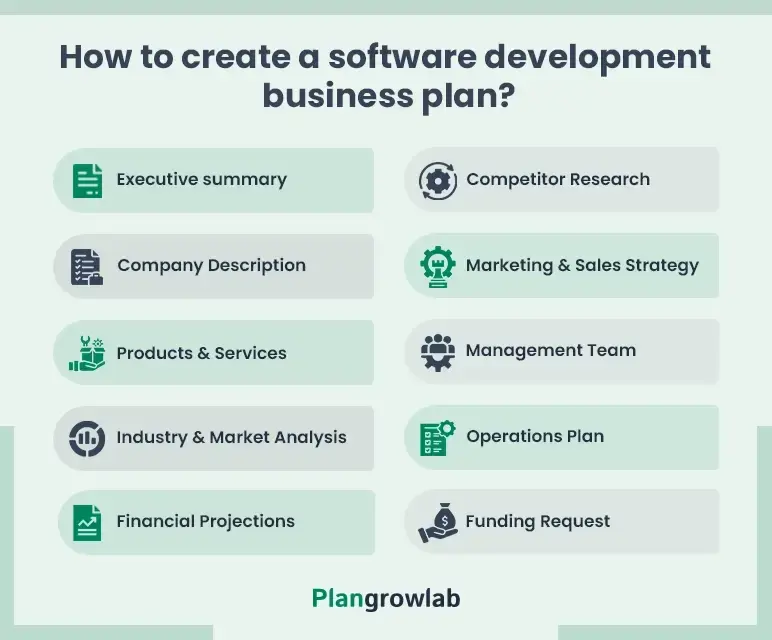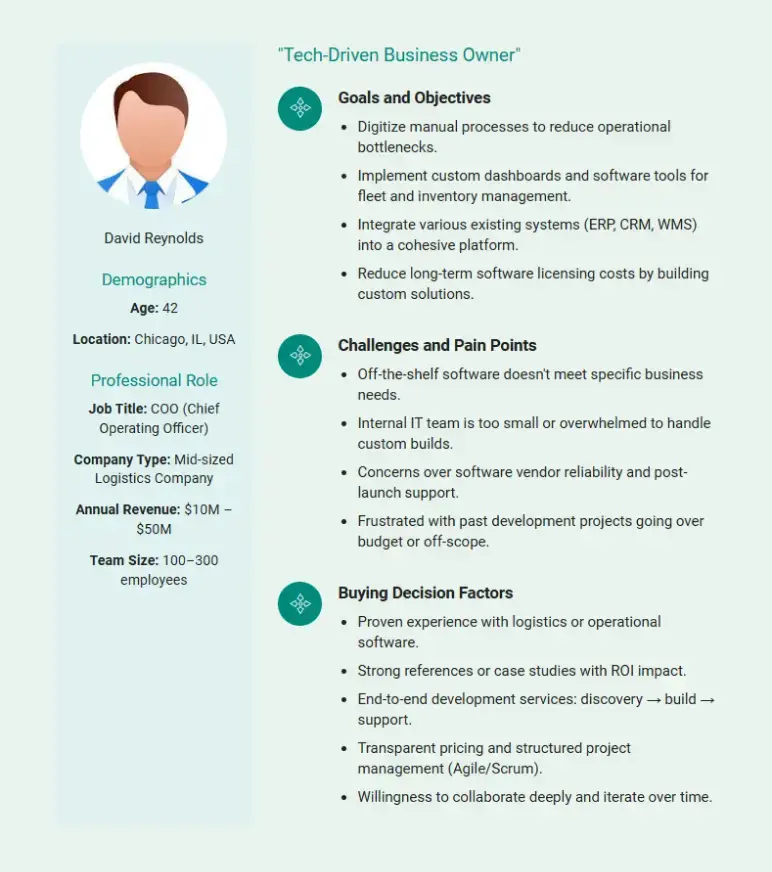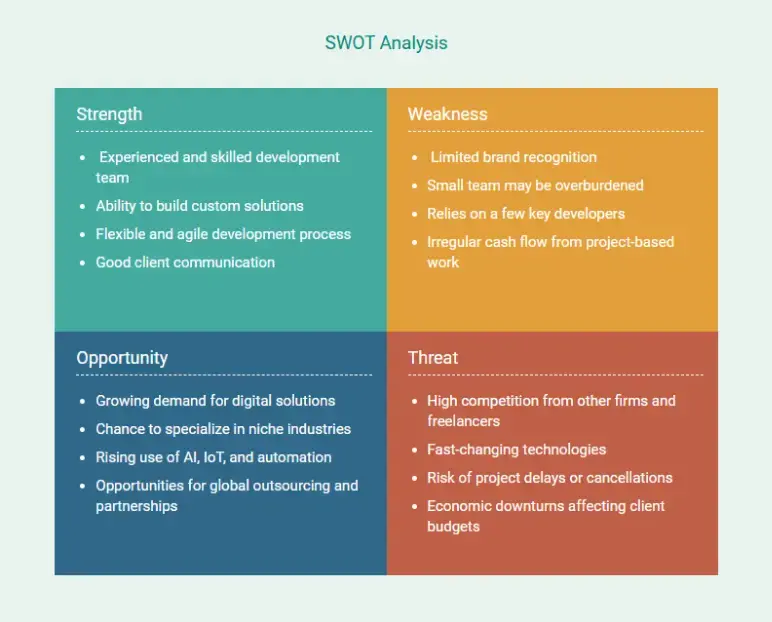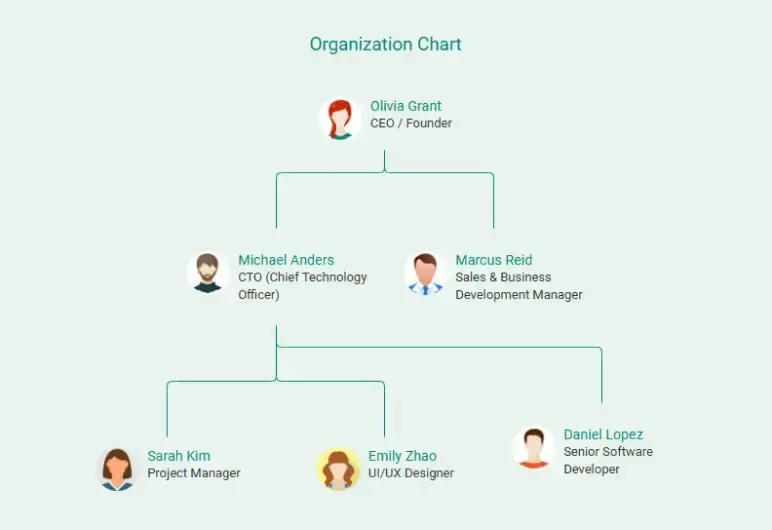So, you’ve decided to launch a software development company? Congrats!
Whether you plan to build the next SaaS powerhouse, a cutting-edge mobile app studio, or a boutique software consulting firm, one thing is certain: You need a business plan.
One that guides you through each stage of starting and managing your venture, from outlining your services and target market to projecting your finances and growth.
Not sure how to draft?
Worry not; this software development business plan template will walk you through it. But first…
Why do you need a business plan for a software development company?
You might be thinking, “I have a great idea and a skilled team – can’t I just start coding and worry about the plan later?”
It’s tempting to jump straight into development, but skipping the business plan is a bit like building an app without any requirements or design.
Here’s why having a business plan is crucial for your software company:
- Gives clarity and direction
- Attracts potential investors or lenders
- Helps identify risks and opportunities
- Enables you to measure progress
All in all, writing a business plan significantly increases your software company’s chances of success.
It provides confidence, both to you as an entrepreneur and to anyone else reading it, that you’ve done your homework and are serious about building a sustainable business.
How to create a software development business plan?
Writing a business plan doesn’t have to be a dreaded chore. Think of it as a series of smaller, bite-sized tasks.
Let’s break it down into key sections that all types of software development businesses should cover. Tackle them one by one, and before you know it, you’ll have a comprehensive plan ready to go!
Here are the main components to include:

1. Executive Summary
The executive summary is the first section of your software development business plan. It offers readers (e.g., investors or lenders) a quick overview of your software company and its roadmap to success, so they can grasp the essentials without reading the whole document.
Even though it appears at the front, try drafting the executive summary after you’ve completed all the other sections of your plan. This way, you can effectively summarize key points from each part.
Here’s what you should cover in an executive summary for a software development business:
- Business introduction: A brief intro of your company – your name, location, and what type of software business you run.
- Product/service offered: What do you build or offer? Mention if you provide custom enterprise software solutions, offer mobile app development services, etc.
- Mission and vision statement: Highlight your software development company’s purpose and what you hope to achieve in the long run.
- Market opportunity: A short summary of the market need or gap you’re targeting. What problem does your software solve?
- Competitive edge: A sentence or two on what makes you different from other software firms.
- Key financial highlights: Investors love numbers, so give a snapshot of your financial projections.
Think of your executive summary as an elevator pitch on paper. Thus, keep the tone clear, upbeat, and factual.
2. Company Description
The company description section provides all the foundational information about your software development business. Think of it as the “who we are and what we do” chapter of your plan.
The following are the key elements to include in this section:
- Your company’s name and location(s)
- Legal structure (LLC, a C-corp startup, or a sole proprietorship)
- Core values or key differentiators
- Background history and current stage
- Milestones achieved (if any)
- Short-term goals and long-term objectives
Moreover, you can add a brief overview of what your company does. Are you focused on mobile app development, cloud software, enterprise systems, or a mix?
By the end of this section, the reader should have a solid grasp of what your company is and aims to be. It’s like introducing your company at a networking event: Clear, concise, and interesting enough to make them want to know more.
3. Products and Services
Now, it’s time to detail what exactly you’re selling.
Since many software businesses offer a mix of products and services, be specific about your offerings.
Begin by listing out your services as well as products. Clearly enumerate what your business will offer to customers. For example, Custom software solutions, mobile app development for iOS and Android, or Software as a Service (SaaS)—a subscription-based web or cloud application.
If applicable, mention other services (optional), like software consulting, training, or ongoing maintenance support contracts.
Further, provide a brief description of each service or product. Explain what it is and the value it provides to the customer. And, don’t forget to highlight the unique features or technologies. Anything noteworthy about your offerings?
Overall, this section should make it crystal clear what a customer will get by doing business with you.
4. Industry and Market Analysis
Here, let’s set the scene with some context about the world you’re entering!
The industry and market analysis section shows that you understand the environment in which your software company will operate and the specific market demand for your services or product.
Start by describing the industry at a high level: What segment of the software industry are you in? Are you in mobile app development, enterprise SaaS, or IT consulting? How is that industry performing overall?
Then, highlight key trends or innovations that affect your industry. Explain how you plan to leverage or address these trends.
Next, zoom in on your target market within that industry:
Target Customers and Needs
Who exactly are you aiming to serve? Describe the group of people or businesses that make up your ideal customer base. And for each segment, paint a quick picture of who they are and what they need. It can help to create a persona. For instance:

Market Size and Growth
Provide an estimate of how big your target market is and whether it’s growing. You might include the number of potential customers or total spending on similar software in your region.
Try to back up your analysis with data wherever possible. If you have stats or graphs (say, a chart of industry growth or market share), include them to make the case more convincing.
This will help you show readers that you’ve done your research and that there’s a viable market for your business. You also ensure that your software company isn’t operating in a vacuum but is grounded in real market demand.
5. Competitor Research
Every business has competition, and your plan should show you’ve studied yours.
The competitive analysis section identifies who else is trying to solve the same problem or serve the same market, and how you’ll differentiate yourself.
Begin with a list of your key competitors. These might be:
Direct competitors – Other companies offering very similar software/services)
Indirect competitors – Alternative solutions your target customers use
For each major competitor, note what they do well and where they fall short: Do they have a strong brand or big clients? A broad feature set? Lower prices? What are their weaknesses? Poor customer service? Outdated technology?
This comparison will highlight the gaps or opportunities that your company can fill.
From that, clearly explain your competitive advantage. How will you stand out? What can you offer that others don’t?
If required, consider including a SWOT analysis—a simple chart of your Strengths, Weaknesses, Opportunities, and Threats.
This internal analysis gives a snapshot of where you excel, what’s holding you back, where you can grow, and what risks to watch out for. It’s a great visual to summarize your competitive position.

Doing so will let you show you’ve thought through your business strategically and feel confident that you have a plan to differentiate your software company in the market.
6. Marketing and Sales Strategy
“If you build it, they will come” – unfortunately, this rarely applies in the software world. Great products or services still need marketing and sales to reach customers. This section is all about how you plan to attract and retain clients or users.
Let’s break this section into two parts:
Marketing Strategy
This covers how you’ll generate awareness and interest in your software business. List the marketing channels and tactics you’ll use, such as:
- Content marketing (blogging about software tips, publishing case studies, and using SEO to draw traffic to your site).
- Social media marketing (sharing content on LinkedIn, engaging on Twitter, maybe showcasing project visuals on Instagram).
- Email marketing (building an email newsletter list, or sending cold outreach emails to prospects).
- Online advertising (Google Ads, Facebook/LinkedIn ads targeted at your ideal client profile, etc.).
- Partnerships (partnering with complementary businesses or joining a startup incubator to meet potential clients).
Also, explain the core branding message and value proposition you’ll communicate in all these marketing efforts. If you have a tagline or slogan, mention it here as part of your brand identity.
Sales Strategy
This part covers how you’ll actually convert interested prospects into paying customers. So, consider discussing:
A. Sales process
Describe the journey from a lead to a signed customer. If you’re selling a product directly online, the process might be more self-service (users sign up on your website or request a demo for B2B sales).
B. Pricing and discounts
Outline how your pricing strategy supports your sales. Perhaps you offer an entry-level pricing tier that lowers the barrier for new customers, or you give a discount on the first project to earn trust.
C. Customer retention & growth
Mention any strategies for retaining clients and encouraging repeat business. Do you provide excellent after-project support or regular software updates? Will you have loyalty programs or discounted rates for long-term contracts?
In short, the marketing and sales section explains how you’ll get clients in the door and keep the revenue flowing. Also, show that you have a proactive plan to generate buzz and close deals; even the best software won’t sell itself!
7. Management Team
People invest in people as much as ideas! That’s why the management team section is vital. This is where you introduce the folks leading the charge: your founders and key executives.
List your core team members and highlight why they’re the right people for this venture.
Provide each person’s name and title/role (CEO, CTO, Lead Developer, etc.), followed by a brief bio emphasizing their relevant experience and skills. Focus on what makes them well-suited to build this software company.
If you have any key roles that are not yet filled, mention how you’re handling that and your plan to fill the gap.
You can even include a simple organizational diagram describing how your team is structured and who reports to whom. Something like this:

If you have notable advisors or a board of directors, list them briefly. Advisors can lend credibility, so mention any who bring significant expertise or connections, especially if your own team is on the smaller/younger side.
Remember, the primary goal of this section is to instill confidence that the people running the company have the capability to execute the plan. Highlight the achievements and expertise that make your team a winning one.
8. Operations Plan
The operations plan details the nitty-gritty of how your software company will run on a daily basis. It describes the processes, tools, and people that will turn your plans into reality.
Here’s how to approach your operational aspects:
Step 1: Describe your development workflow. How will you produce your software or deliver your service?
Step 2: Explain your facilities and equipment. Are you operating from an office or fully remote? Do you need any special equipment or infrastructure?
Step 3: If applicable, mention any key suppliers or external resources. Maybe you rely on cloud services (AWS/Azure), or you use certain third-party APIs in your software.
Step 4: Shed light on your operational milestones. It can be helpful to include a brief timeline of near-term operational goals. This ties your operations to concrete targets.
By providing details on your daily operations, you make it clear that you can deliver what you promise to customers in a reliable and efficient way. This assures the reader that you take your business from theory to practice.
9. Financial Projections
This section outlines your software company’s financial projections for the next 3-5 years of operation. This is often one of the first things investors look at, so it must be clear and realistic.
First of all, clearly state the assumptions behind your financial projections. All forecasts are based on assumptions, so it’s important to outline them.
Explain clearly how your business will make money. Is it through one-time project fees? Hourly billing for development services? Monthly subscriptions to your app? Advertising or in-app purchases? Spell out your revenue streams.
Next, provide a forecast of your revenues, major expense categories, and profit (or loss). Also, jot down the growth trajectory. This reassures readers that you have a path to profitability.
A full business plan would include standard financial statements:
- Income statement (profit & loss statement)
- Cash flow statement
- Balance sheet
- Break-even analysis
Further, you may include financial charts or tables if possible. For instance, a simple bar chart of projected annual revenue vs. expenses can powerfully illustrate your growth plan and when you expect to turn profitable. Visuals make the numbers easier to digest.

Make sure that you show optimistic growth, but it should be grounded in sensible assumptions.
Why? Investors have seen plenty of over-optimistic hockey-stick graphs, so showing steady, believable growth (and maybe even a little cushion for contingencies) will make your plan more credible.
10. Funding Request (if any)
If you’re seeking outside funding for your software company, dedicate a section to the funding request. If you’re planning to self-fund or bootstrap and don’t need investors or loans, you can skip this section.
In the funding ask, you should clearly answer these questions:
- How much money do you need? Be specific.
- What type of funding? Clarify whether you’re looking for equity investment, a loan, or maybe a grant.
- What will you use it for? Explain how the funds will be used.
You can provide a breakdown of your planned use of proceeds. Investors want to know their money will directly fuel growth, not just sit in the bank.
A simple breakdown (often called use of funds) could look like:
| Category | Amount (USD) | Purpose / Description |
|---|---|---|
| Team Salaries (First 6–12 Months) | $80,000 | Pay for developers, PM, and designer |
| Office & Equipment | $15,000 | Laptops, software licenses, cloud infrastructure |
| Marketing & Lead Generation | $20,000 | Website, SEO, ads, email campaigns |
| Legal & Administrative Setup | $5,000 | Company registration, contracts, legal fees |
| Project Management Tools | $3,000 | Jira, Slack, Zoom, GitHub subscriptions |
| Contingency Reserve | $7,000 | For unexpected costs and cash flow buffer |
| Total Funds Needed | $130,000 |
Moreover, you can briefly mention what this funding will accomplish and how it benefits the funder.
If you’re taking a loan, explain how and when it will be repaid. If it’s equity, you might hint at the possible exit strategy (acquisition, rapid growth leading to high ROI, etc.).
Download a free software development business plan template
Writing a business plan is much easier when you have a solid starting point. To help you get going, we’ve prepared a free software development business plan template.
This template includes guided sections and prompts so you won’t miss anything important. It’s available in an easily editable format, so you can fill in the details of your company and save a ton of time. Or else, you can customize it to fit your needs.
Summary
Let’s sum up! We’ve covered everything from defining your business and researching your market to outlining your marketing, operations, and financial plan.
Now, crafting a business plan for your software company should be much easier for you.
However, if you find yourself stuck or unsure about any section, consider reaching out to professional business plan writers at Plangrowlab. Our team specializes in helping entrepreneurs get personalized advice and fine-tune their plans.
So, don’t hesitate! We’re here to help you turn ideas into thriving businesses!
Frequently Asked Questions
What key elements should be included in a software company's business plan?
Your software company business plan should include these key components:
- Executive summary
- Business overview
- Market analysis
- Products and services
- Sales and marketing plan
- Management team
- Operations plan
- Financial projections
Is it worth hiring professional business plan writers or consultants?
Yes, hiring a professional business plan writer or consultant can be worth it, especially if you're looking for funding or want a polished, investor-ready plan. They can help you organize your ideas, do proper market research, and present everything clearly.
How can I differentiate my software company from competitors?
To stand out from other software companies, focus on what makes you different. Here’s how:
- Solve a specific problem well
- Offer a better user experience
- Provide fast, helpful customer service
- Be transparent with your pricing
- Focus on a specific industry or user group
Why is marketing important for a software development company?
Marketing is important for a software development company because it helps attract clients, build credibility, and showcase your expertise. It sets you apart from competitors and keeps your business visible in a crowded market. Without it, even great services can go unnoticed.
How long does it take to write a software development business plan?
Writing a software development business plan can take anywhere from a few days to several weeks. If you already have a clear idea and use a good business plan template, you can save time and finish in 3–5 days. But using the right business planning tools can speed things up and make the process much easier.

